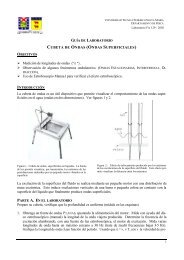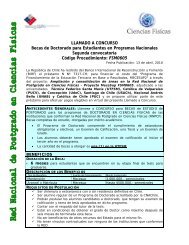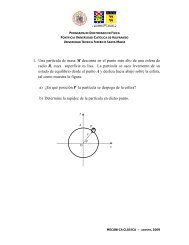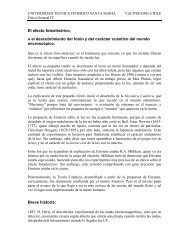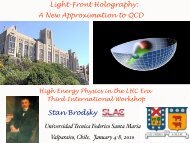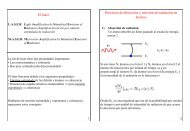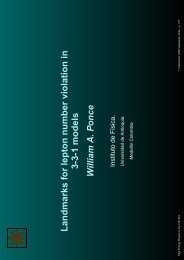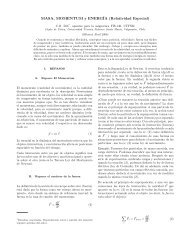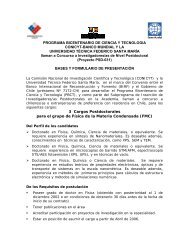Aca - Departamento de Física - Universidad Técnica Federico Santa ...
Aca - Departamento de Física - Universidad Técnica Federico Santa ...
Aca - Departamento de Física - Universidad Técnica Federico Santa ...
You also want an ePaper? Increase the reach of your titles
YUMPU automatically turns print PDFs into web optimized ePapers that Google loves.
V Encuentro Sud Americano <strong>de</strong> Colisiones Inelásticas en la Materia<br />
INTERACTION DYNAMICS OF CLUSTERS IN INTENSE<br />
LASER FIELDS<br />
D. Vernhet 1 , E. Lamour 1 , C. Prigent 1 , C. Ramond 1 , R. Reuschl 1 , J.-P. Rozet 1 ,<br />
M. Trassinelli 1 , J. Burgdörfer 2 , C. Deiss 2 , G. Schiwietz 3<br />
1 Institut <strong>de</strong>s NanoSciences <strong>de</strong> Paris, Université Pierre et Marie Curie, CNRS-UMR7588<br />
F-75252 Paris, France, EU<br />
2 Institute for Theoretical Physics, Vienna University of Technology,<br />
A-1040 Vienna, Austria, EU<br />
3 Helmholtz-Zentrum Berlin für Materialien und Energie GmbH<br />
D-14109 Berlin, Germany, EU<br />
Large clusters, similarly to solids, couple very efficiently to intense subpicosecond laser pulses.<br />
Nearly 100 % of the laser radiation can be absorbed, leading to the observation of highly charged<br />
ions with energies reaching MeV and electrons with energies up to a few keV. A fascinating feature<br />
of this interaction is its efficiency for converting photons in the eV range to x-rays with keV<br />
energies. Whereas spectroscopy of the emitted ions maps the final stage of the Coulomb explosion,<br />
i.e. a few microseconds after the femtosecond laser pulse and the cluster disintegration, x-ray<br />
spectroscopy gives access to the dynamical evolution of the irradiated cluster on a time scale<br />
comparable to that of the laser pulse duration. Since the inner-shell vacancies are produced by<br />
electron-impact ionisation, x-ray spectroscopy can provi<strong>de</strong> insight into the electron dynamics and<br />
more precisely on the heating mechanisms, which allow electrons to gain energy as high as the innershell<br />
binding energies. KeV x-rays provi<strong>de</strong> a “thermometer” of the hot electrons in the cluster, acting<br />
as a probe of the energy distribution on the high energy si<strong>de</strong>.<br />
Rare-gas clusters- (Ar) n , (Kr) n and (Xe) n with n > 10 4 (i.e. 10-40 nm of diameter)- irradiated with<br />
intense (I



